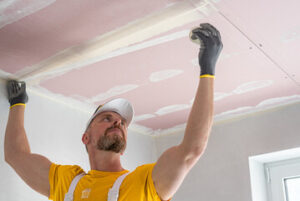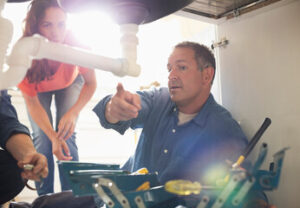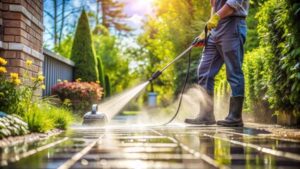A well-maintained ceiling improves a room’s appearance and ensures structural integrity. Small issues like cracks can worsen over time and should be repaired early.

Addressing water damage on a ceiling involves finding the source and properly drying the area. Failure to do so may lead to mold or other serious problems. Contact Ceiling Repairs Perth for professional help.
While some cracks are merely cosmetic in nature, others may indicate a structural issue that should be addressed immediately. It is important to inspect ceilings regularly and address any signs of damage as soon as they are spotted. By doing so, you can prevent larger issues from arising and protect the integrity of your home or office.
There are a few ways that cracks in your ceiling can be fixed, depending on the size and severity of the problem. In some cases, a small crack can be repaired by applying a skim coat of drywall compound over the area. In more severe cases, a product such as Durabond can be used. If you have a textured or blown ceiling, you will need to match the texture of your patch with the rest of the surface. You can do this by spraying a small section of the ceiling with an aerosol texture spray or using a texture roller. It is important to test the spray or roller on a piece of cardboard first to make sure that it matches the texture and application technique of your ceiling.
If a crack is the result of water damage, it will need to be completely dried before any repairs can be made. A professional plumber should be able to help you with this. Once the area is dry, a filler such as Spackle or drywall mud can be applied to the affected area. For hairline cracks, a product called Mad Dog Crack Fix is recommended by some forum users. For best results, the crack should be opened a bit with a metal scraper before applying the filler to ensure good adhesion.
Cracks in the ceiling are most often caused by the natural settling of a house, but they can also be due to a number of other issues. Leaky roofs and plumbing, foundation problems, and condensation can all cause cracking of your ceilings, and if not fixed promptly, these cracks can lead to more serious issues such as mold growth or structural damage. It is always best to seek professional drywall and paint contractors to assess the issue and make any necessary repairs.
Water Stains
Water stains on ceilings can be unsightly, but they’re also often a sign of serious underlying issues. Left untreated, these stains can lead to mold and mildew growth, deteriorated insulation, and compromised structural elements. Fortunately, water stains can be repaired fairly easily.
The first step is to identify the source of the water stain. In most cases, the water that stains the ceiling has leaked from somewhere above it. This can include the roof area, an upper-level bathroom, or plumbing lines. In the attic, look for signs of a leak such as wet insulation, water marks on rafters or roof decking, and daylight entering through gaps.
Next, inspect the drywall for damage or discoloration. If the drywall is damaged or discolored, it’ll need to be replaced or thoroughly scraped and cleaned before repainting. It’s important to match the color of the new paint as closely as possible with the existing color on the rest of the ceiling. This is not always an easy task, however, as paint colors can fade over time due to exposure to sunlight and other environmental factors.
Finally, if there is any mold or mildew present, it must be treated and removed before continuing with the repairs. This may require a more extensive drywall repair or replacement, depending on the extent of the mold and mildew damage.
For minor water stains that aren’t accompanied by any mold or mildew, the best way to remove them is to mix a solution of equal parts white vinegar and water and apply it to the stained area using a sponge. This will help to neutralize the acid in the solution, which should cause the stain to disappear after several minutes.
Once the stain has been removed, use a paint or primer that is designed for water-damaged surfaces to ensure better coverage and a more seamless finish. Be sure to choose a product that specifically says ‘stain block’ or ‘stain sealant’ on the packaging, and follow the instructions as recommended. Then, repaint the affected area to restore its appearance. If your home experiences persistent water stains on the ceiling, contact a professional property restoration company to diagnose and fix the underlying issue.
Holes
Holes in the ceiling are not only unsightly, but they can also be a sign of serious problems with the structure of your home. In many cases, a hole in the ceiling can be repaired, but it is important to consult with a professional to ensure that the problem is addressed correctly. This will prevent further damage and can help to protect the value of your home.
The first step in repairing a hole in your ceiling is to clean the area thoroughly and remove any debris that may be present. Next, you will need to decide what type of patch you are going to use. For small holes, you can often get away with Spackle or a similar product. For larger holes, you will need to cut a piece of new drywall that is slightly larger than the hole and attach it using drywall screws. Once the patch is in place, you will need to apply several layers of joint compound and sand it after each application.
If you have a plaster ceiling, you will need to do a bit more work to repair the hole. First, you will need to clean the area and remove any loose plaster. Then you will need to add support in the form of timber cleats. Once the cleats are in place, you will need to add a layer of mesh tape and then cover it with joint compound. Once the compound is dry, you will need to sand the area until it is smooth and then finish it with a coat of paint that matches the rest of your ceiling.
Once the repairs are complete, it is important to take a look around the area to make sure there are no other signs of damage or weakness. You will also want to check for areas that might be affected by the water damage, such as wall panels or woodwork. If you find any other issues, it is a good idea to consult with a professional to ensure that they are fixed before they become more serious.
Structural Issues
The structural integrity of a ceiling is essential for ensuring safety and comfort, especially in homes with young children or elderly adults. If left unattended, structural issues can lead to ceiling collapse and serious injuries. The best way to prevent such problems is to have a professional inspect the condition of your ceiling regularly and perform timely repairs.
Ceiling cracks can occur for a variety of reasons. If the cracks are hairline or straight, they may be easy to repair for a DIYer. However, larger cracks can indicate more significant issues with your structure that will need to be addressed by a professional. Depending on the severity of the crack, you may need to reinforce the support beams or joists or replace sections of the ceiling.
Water stains or discoloration on the ceiling are often caused by a leak, which can be due to faulty plumbing, roof damage, or clogged gutters. While water stains and discoloration may be unsightly, it is most important to fix the underlying issue so that mold does not take hold. Once the problem has been resolved, it is then possible to repair the damaged drywall.
Another common cause of ceiling cracks is the shifting of the foundation of a building. This can occur as a result of poor construction, uneven soil conditions, or natural ground movement over time. Regardless of the cause, this type of cracking can be dangerous for residents and must be repaired by professionals.
Other structural issues include sagging or weak ceilings, cracked joists or rafters, or broken or loose beams. These are all problems that require a professional inspection and can be costly to repair.
Regular inspections and preventive maintenance are the best ways to keep your ceiling in good shape. These practices will help you spot small problems before they turn into bigger and more costly repairs. By following these simple tips, you can extend the life of your ceiling and make your home or business more attractive to potential buyers if you ever decide to sell.



